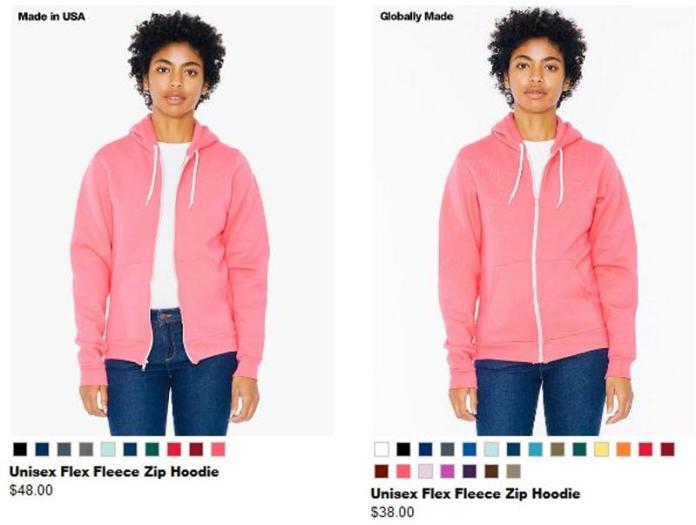When Canadian brand Gildan acquired American Apparel for a cool $88 million in January of this year, it only bought American Apparel’s intellectual property (the name, brand, and designs), leaving its operations (the stores and factories) to shutter.
That move revealed Gildan’s strategy: Keep American Apparel alive, only dial down the made-in-America part. CEO Glenn Chamandy went on to confirm this tactic with investors earlier this year, revealing that the new AA would still offer some products made on American soil but that Gildan, which specializes in making cheap basics with its global supply chain, would essentially be taking American Apparel international.
This week Gildan relaunched American Apparel’s e-commerce site and, yep: it’s the same photography (though a slightly less…provocative edit), same logo, and same clothes. The only difference, other than the fact that the assortment has been edited down to American Apparel’s greatest hits, is that most of the pieces are now what Gildan is calling “globally made” and therefore cheaper. In other words: American Apparel isn’t quite so American anymore.
It’s a little unclear where exactly on the globe the clothing is produced, since the product descriptions simply say “imported,” but Gildan has pumped other sections of the site with manifestos that hark back to American Apparel’s original pitch as not only a maker of sexy hipster basics, but also an ethically made, racially diverse brand you could feel good about supporting. (Until, of course, you couldn’t.) There are sections on the new website which highlight the company’s emphasis on diversity in advertising, green energy, and healthcare opportunities for workers. In a section dedicated to telling “Sweatshop Free Stories,” a header above a video interview with a Honduras-based factory worker reads:
At American Apparel we’ve always believed in sweatshop free and ethical manufacturing. We’ve also always believed that border lines are pointless. Today we are spreading our beliefs one step further – globally giving more ethical jobs to more people around the world. We visited our new factories and team members in Honduras and decided to share with you their amazing stories. That’s American Apparel!
As promised, there is a selection of USA-made products available as well. Gildan makes a big show of comparing these items to their globally-made “twins”: A banner above the USA-made products reads, “We are sweatshop free and ethically made regardless of location. You decide.” Below, shoppers choose between identical hoodies, T-shirts, and tank tops based solely on country of manufacture (or, U.S. versus “global”)—and price. The USA-made products are about 20% more expensive than their globally made counterparts, and available in fewer colors.
Gildan might still be calling the brand American Apparel, and leaning into the original AA’s history as a provocative, activism-driven brand, but it’s clear they think they whole made-in-America thing is beside the point. The USA-made capsule effectively functions as reverse marketing for the main, internationally-produced (sorry, “Globally Produced”) line. None of the styles are exclusive, or made with premium materials, or even photographed in a special way. We wouldn’t be surprised to see it eventually phased out completely. At which point the only thing American about American Apparel will be the name.










GIPHY App Key not set. Please check settings